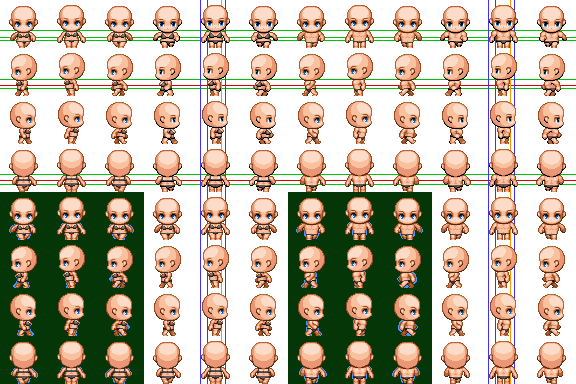

But if you want to get fancy, you can try adding the 4 angles. Secret of Mana, and A Link to the Past, are a couple examples that come to mind. Applying 4 directions to 8 directional movement was common practice with many 16-bit games and still looks good to me. I suggest starting with a basic nude, which you can easily build off and accessorize.Īlthough we only have the sprite in 4 directions, you can still implement 8 direction movement and it will look acceptable when any of the 4 directions veer off at an angle. Once you are satisfied with the animation you can use these frames as the base for all characters in your game with similar proportions. The frames with the arms swinging can simply be reflected for the up and down facing versions. The walk cycle borrows all its frames from the run cycle, but simply omits the frames where the character is in full stride, and the playback speed is slower. While my walk cycle is 4 frames and the run cycle is 8, you don’t really need to create that many unique poses. It’s best to keep the sprite very basic at this point and add details after you are satisfied with the motion. Once you have created the idle position of the sprite facing 3 directions you can begin creating a walk/run animation. However, overlap along the X axis is arbitrary and confusing to the eye. Therefore, it looks perfectly natural and improves the sense of depth to allow the top half of a 2 tile high sprite to overlap sprites that are just a bit higher on the screen. With the top down viewpoint there is implied depth along the Y axis, as we assume objects lower on the screen are closer. Conversely, pixels spilling out of the frame may lead to unwanted overlap. However, you don’t want there to be too much empty space around your character, as to avoid pronounced gaps with adjacent sprites and parts of the environment with collision. Note, the frame of the sprite size is relative and the character doesn’t have to completely fill it edge to edge. While modern tools allow one to break the grid and create sprites and environments of arbitrary size, the snug logic of the grid-based approach is still common convention. For example, 1 tile wide by 2 tiles tall is one of the most common sprite sizes, and is the size I’ve chosen for my example.īasing the character size on tile units allows the sprite to naturally fit in the grid-like structure of the tile based world, with simple collision bounds also defined by tile units. The height and width can multiply independently. As shown in the lower section of the above tutorial, relative sprite size usually conforms to a tile unit, or multiples of the tile unit. Generally, tile size is the best gauge for determining sprite size. Before you jump into character design it’s important to establish the sprite size, as the size of your characters can strongly affect the look and feel of your game.


 0 kommentar(er)
0 kommentar(er)
